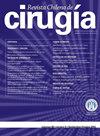Hernia umbilical en pacientes cirróticos con ascitis. ¿Tratamiento conservador o quirúrgico?
Q4 Medicine
引用次数: 0
Abstract
Ascites is the most common complication in patients with liver cirrhosis. Umbilical hernias (HU) occur in 20% of these patients and 40% in those with severe ascites. HU occurs due to increased intra-abdominal pressure, weakening of the abdominal fascia and loss of muscle mass. In addition, they have a tendency to enlarge rapidly and present high risk of complications that threaten the patient’s life. The treatment of the uncomplicated HU is controversial, both the surgical management (herniorrhaphy) and the conservative management (control of ascites) present high rate of complications, consequently high morbidity and mortality. Currently, umbilical herniorrhaphy is recommended with prior control of ascites in uncomplicated HU management, it reduces the risk of surgical wound infection, evisceration, ascites drainage, peritonitis, and it reduces up to 41% of HU recurrence. The success of this approach also depends on the degree of liver dysfunction. The treatment of complicated HU is surgical (herniorrhaphy without mesh), with lower mortality rate compared to conservative management. Studies reveal advantages of umbilical herniorrhaphy laparoscopy (minimally invasive and stress-free) compared to open surgery; however there is still no evidence about it.肝硬化腹水患者脐疝。保守治疗还是手术治疗?
腹水是肝硬化患者最常见的并发症。脐疝(HU)发生率为20%,严重腹水发生率为40%。HU的发生是由于腹内压力增加,腹筋膜减弱和肌肉量减少。此外,它们有迅速扩大的趋势,并呈现威胁患者生命的并发症的高风险。无并发症HU的治疗存在争议,无论是手术治疗(疝修补)还是保守治疗(控制腹水)都存在高并发症发生率,从而导致高发病率和死亡率。目前,在无并发症的HU治疗中,建议在事先控制腹水的情况下进行脐疝修补术,这样可以降低手术伤口感染、内脏取出、腹水引流和腹膜炎的风险,并可降低高达41%的HU复发率。这种方法的成功还取决于肝功能障碍的程度。复杂性HU的治疗是手术(无补片疝修补术),与保守治疗相比死亡率较低。研究表明,与开放手术相比,腹腔镜脐疝修补术(微创和无压力)具有优势;然而,仍然没有证据证明这一点。
本文章由计算机程序翻译,如有差异,请以英文原文为准。
求助全文
约1分钟内获得全文
求助全文
来源期刊

Revista Chilena De Cirugia
Medicine-Surgery
CiteScore
0.20
自引率
0.00%
发文量
0
审稿时长
6-12 weeks
期刊介绍:
La Revista Chilena de Cirugía es un órgano de difusión del conocimiento y actividad quirúrgica. Su población objetivo son cirujanos, especialistas de otras áreas médicas, médicos generales y alumnos del área de la salud.
Sirve a cirujanos y otros especialistas, para publicar artículos originales e inéditos sobre temas médicos, en particular artículos de investigación básica y clínica, artículos de revisión, entre otros.
Buscan difundir y actualizar el conocimiento médico general y quirúrgico en particular. Se publica en forma bimestral.
La Revista Chilena de Cirugía está afiliada y patrocinada por la Sociedad de Cirujanos de Chilese desde el año 1952.
 求助内容:
求助内容: 应助结果提醒方式:
应助结果提醒方式:


